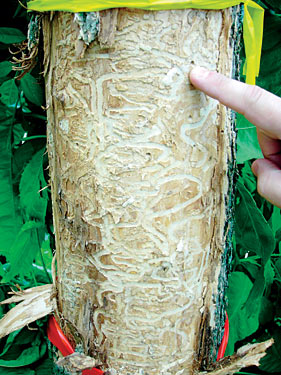As the mosquitoes start to disappear, and the leaves begin their fall beauty, we may be hitting our woods more frequently for hiking, horseback riding, bicycling or ATVing. But do you know what may be hitchhiking along with you? Many of the exotic plants, insects and diseases invading our woods are fairly immobile until we pick them up and carry them home or to other woodlands.
A group of recreationists and foresters came together a few years ago to develop a list of recommendations for how we can slow and prevent the spread. Other groups came together to develop similar recommendations for forestry practices and urban forestry. If you are interested in reading about those as well, you can check out the Invasive Species Best Management Practices website. One of the campaigns that came out of the recreation group was called “Slow the Spread by Sole and Tread”, which is the main topic for this blog. Here are four of the main recommendations from the group:
- Learn to recognize invasive species- Take some time to learn what invasive species are of concern in your area, and easy ways to identify them. This is a big step in knowing whether to report your sighting, try to control them or whether to avoid them all together. (Some invasives, such as wild parsnip, can cause terrible rashes.) The WI Dept of Natural Resources has a nice field guide for identifying invasive plants , and some tips on control. You can find information on several invasive insects on the Brown Co UWEX website .
- Stay on designated trails & avoid areas with invasives- In areas where trails are maintained, you are less likely to pick up seeds or plant parts of invasives. When you do see a patch of invasives, avoid that area.
- Prevent the long-distance transport of invasives- It Is recommended that you not transport firewood more than 25 miles. In fact, in some areas of the state that are quarantined for emerald ash borer, no wood products can be removed from those counties. Gypsy moth , oak wilt or emerald ash borer can survive your trip, and infect the trees around where any firewood might be left. It is also a good idea to inspect your car, boat, ATV or other equipment for gypsy moth eggs which also travel well.
- Inspect & remove seeds and plant parts- Prior to leaving your woods (or any wooded area), check yourself, your clothes, pets and equipment for seeds or plant parts. Remove them, and leave them onsite. Hair, fleece, pant cuffs, and shoe laces are good places to start checking. Carry a boot brush, and clean out the treads of your shoes and tires. Consider washing vehicles and bicycles at a car wash to prevent the spread through dirt brought with you.
Our native trees and plants depend on your help for a healthy future. Check out the entire list for more recommendations for slowing the spread.
